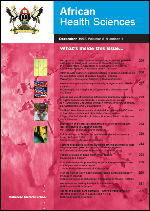
|
African Health Sciences
Makerere University Medical School
ISSN: 1680-6905
EISSN: 1680-6905
Vol. 3, No. 1, 2003, pp. 33-39
|
 Bioline Code: hs03007
Bioline Code: hs03007
Full paper language: English
Document type: Research Article
Document available free of charge
|
|
|
African Health Sciences, Vol. 3, No. 1, 2003, pp. 33-39
| en |
Screening for Disability in a Community: The 'Ten Questions' Screen for Children, in Bondo, Kenya
Muga, Emily
Abstract
Background: Although the need for early identification and interventions of disabilities is evident, the current state of routine screening practice in Kenya needs intensive training of screeners before more rigorous techniques are introduced.
Objective: To compare the precision and practical utility of the 'ten questions' and EARC screens among the 2 - 9 year olds in a community setting.
Method: In this analytical comparative cross-sectional survey of two disabilities screening methods. multiphase sampling and multistage data collection procedures were employed. Quantitative research utilizing structured interview checklist was used for data collection. It described the prevalence rates of different types of disabilities using both methods. It analyzed the precision and practical utility of the two methods in a community setting.
Results: 64 of the 399 children under study were disabled (50.5 % male and 49.5 % female). The 'ten questions' picks up only those problems that are of great concern to families. EARC services are a more definite case defining process of measuring the existence and degree of disability in children. It screens the children who are severely disabled leaving out the mildly disabled and medical conditions which, when left untreated, could lead to possible disablement.
Conclusion: Parents need to be sensitized about symptoms requiring the ten questions that can be used to screen out the potentially disabled children and the Education Assessment and Resource Centres (EARC) be used to diagnose the type and degree of the disability and refer the ill children for treatment. The basic needs of disabled children could be met in the community and do not require highly specialized personnel. They need to be localized and accessible.
|
| |
© Copyright 2003 - Makerere Medical School, Uganda
|
|
